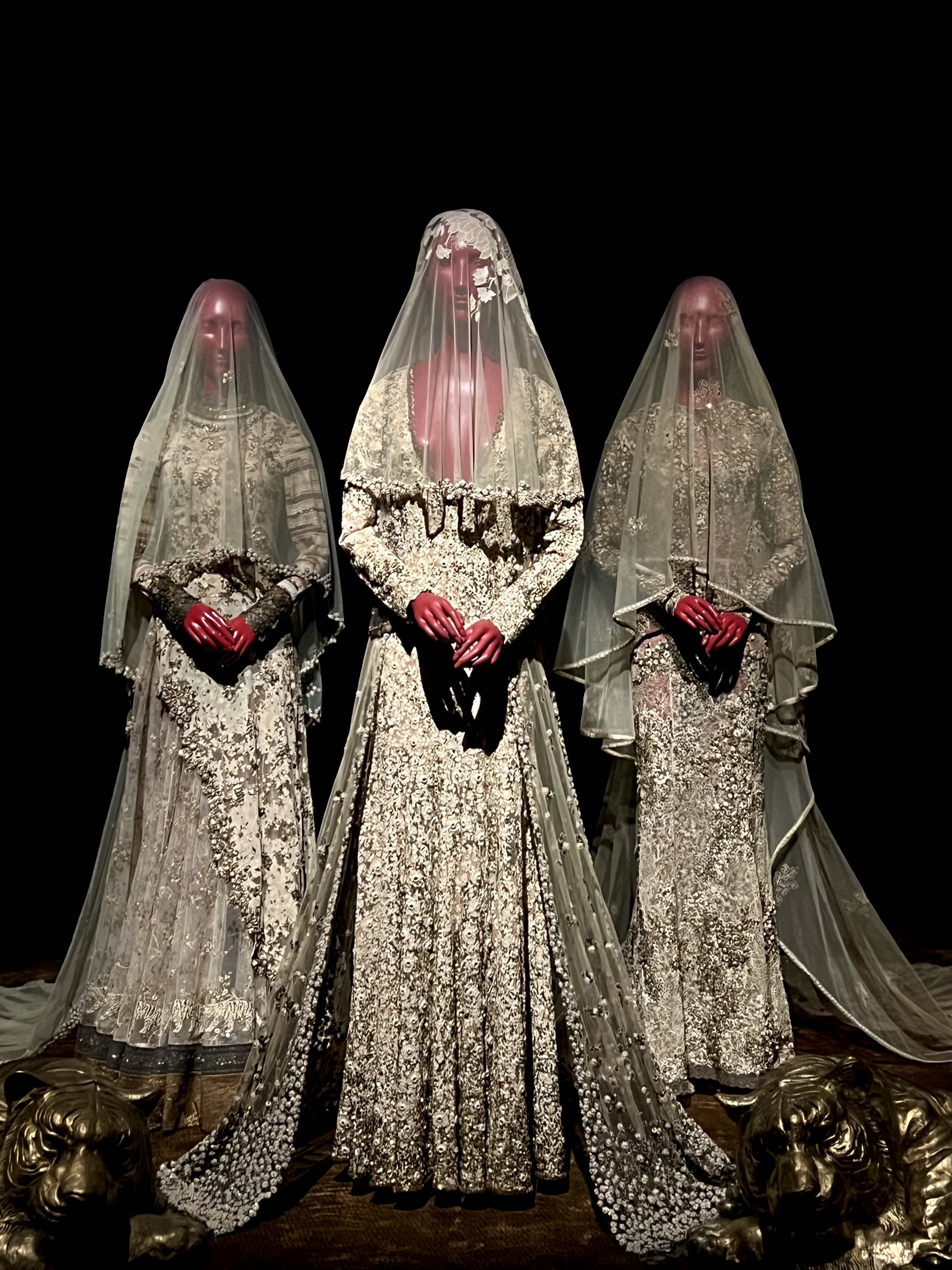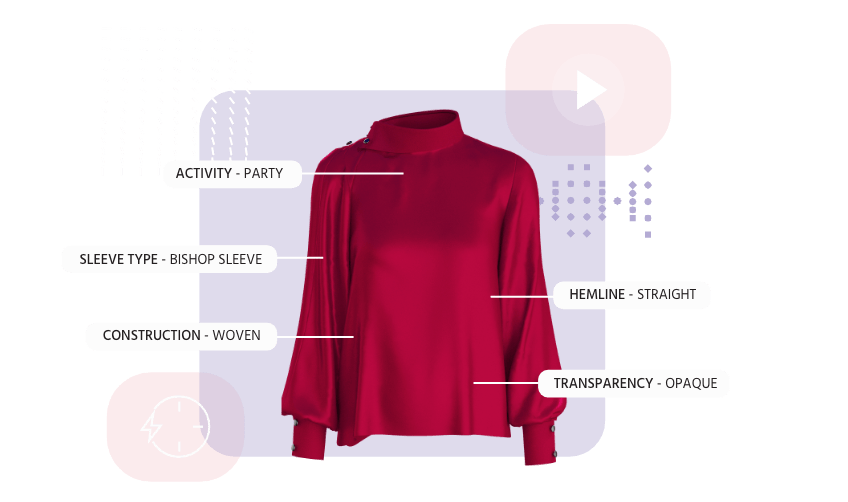
A peek into "India in Fashion" exhibition at NMACC part 2
VALENTINO - A marriage of East and West
This section displays the Valentino couture wedding Lehenga designed for Isha Ambani’s 2018 wedding as a symbolization of the convergence of East and West. The Haute couture Creative Director Pierpaolo Piccioli along with artisans created this ensemble to highlight the beauty of Indian artistry.

THE JOURNEY OF THE SARI – An icon of attire takes its place in the history of western fashion
Displayed in the following series of exhibits is the Sari, the quintessential symbol of Indian clothing, and its impact on both traditional and modern designs by Indian and international designers. Among the Indian designers, we see works of Tarun Tahiliani, Anamika Khanna, Ritu Kumar and Raw Mango’s Sanjay Garg.


By the early 20th century, the influence of the Sari was evident in the works of international designers such as Paul Poiret, Elsa Schiaparelli, Madame Grès, Cristóbal Balenciaga, Hubert de Givenchy, Mainbocher, Jean Paul Gaultier, Zandra Rhodes and Valentino among others whose pieces are displayed in the different spaces of this section.

THE GREAT EXHIBITION LONDON 1851 – The power of India in an age of influence
In May 1851, Queen Victoria inaugurated The Great Exhibition showcasing the works of the industry from all nations in London’s Hyde Park. Regarded as the Kohinoor of the British crown, India was given the largest space at the centre of the exhibition, with Indian textiles being the highlight. Indian text also played a significant role in shaping the future Victoria and Albert Museum, along with a particular emphasis on Indian artifacts. The Great Exhibition serves as the inspiration for the design of the following exhibit space and the many pieces displayed here.
During the early 20th century, when the British Raj was at its peak, India's handloom production for export was severely affected by Britain's industrial revolution and mechanized imitations. However, Lady Mary Curzon, the Vicereine of India, turned her wardrobe into a showcase of India's embroidery. This section of the exhibition features a court dress made of French silk, which was embroidered in India and then sent to Paris to be incorporated into the gown. The resulting gown was worn in India between 1903-1905 and is returning to India for the first time since then.


The fashion of India's royalty has continued to inspire designers, such as Jean Paul Gaultier, as seen in the gold-embroidered suit from 2000 on display, paired with a Brocade Sherwani belonging to Sir Jagatjit Singh, the last ruling maharaja of Kapurthala.

The center table showcases historical accessories, embroideries, and other fabrics alongside contemporary shoes by Christian Louboutin, who created several special pieces for the exhibition.

THE HIPPIE TRAIL – Fashion takes a trip
In the 1960s, India symbolised imaginative freedom, far removed from the gloomy atmosphere of post-war hardship and restraint. During this tumultuous era, as the Vietnam war intensified, interest in India was reignited and boosted by the popularity of jet travel, which made it possible for many tourists to visit the country. In 1968, The Beatles made a spiritual trip to an ashram in India and returned to London wearing humble cotton kurtas.
Around the same time, the esteemed Indian designer Ritu Kumar was at the forefront of reclaiming India's textile and design heritage for the country itself, breaking free from imperialist ideas and the imposition of Western dressmaking techniques under the British Raj. Kumar is credited with reviving hand block printing in Bengal and raising awareness of zardozi craftsmanship in the 1970s through her efforts to introduce Indian craft and textile aesthetics to European and American audiences.
In this section of the exhibition, one can admire the works of Jean Paul Gaultier, Zandra Rhodes, Austin American designer Rudi Gernreich, Thea Porter, and others.
Contemporary designers such as John Galliano, Manish Arora, and Dries Van Noten also take us on a fashion journey celebrating India in their collections, while actively supporting Indian artists.

TRADITIONS AND INNOVATIONS – The power of Indian fashion now
The rich textile and craft heritage of India is an integral part of the identity of Indian designers. By modernizing traditional crafts, techniques, and traditions from various regions of the country, these designers have developed a unique identity for themselves. They have utilized the language of fashion to create opportunities for artisans to practice their craft in a world where fast fashion dominates. As a result, craft and craftsmen from India are now being celebrated on a global scale. Previously relegated to the background, India is now receiving recognition for its contributions to the fashion industry. As society continues to evolve, India is finally receiving its due credit as a valuable contributor to the global lexicon of fashion. This final section of the exhibition highlights the works of well-known Indian designers who have gained recognition worldwide.
Throughout his three-decade-long career, Manish Malhotra has not only styled numerous Indian films but has also established a highly popular eponymous label. Malhotra presents two exquisitely crafted garments that highlight the Chikankari and Phulkari crafts.

Anuradha Vakil is an Ahmedabad based designer who began her career in the 1900s. The following space displays four very distinct commissioned pieces by the designer among which is a special piece created for a long-time client and patron, Nita Mukesh Ambani.

Abu Jani and Sandeep Khosla's designs are known for their striking contrasts. As fashion veterans, they have a wide range of patrons, including renowned names like Beyonce and Dame Judi Dench. The following segment showcases three of their pieces.

Sabyasachi Mukherji has brought India to the forefront of the global fashion map by using a design language that is firmly rooted in the India’s old-world glamour, but rewritten for the present. Through a series of collaborations with international brands, and his ventures into jewellery and home decor, Sabyasachi has created a unique and exclusive universe of his own. In this exhibition section, three veiled brides wearing white lace dresses circa 2013-2015 are displayed, with two iconic Sabyasachi tigers on either side of the mannequins.

Rahul Mishra made history by becoming the first Indian designer to feature on the Paris Haute couture week calendar. The final exhibition section showcases three ensembles from his Spring 2023 couture line-up, titled 'Cosmos,' which seamlessly blend earthly and celestial motifs.

In conclusion, the ‘India in Fashion’ exhibition is a testament to the country's rich cultural heritage and a celebration of its contribution to the global fashion industry.

Limitations of ChatGPT and how you can overcome it for Fashion



